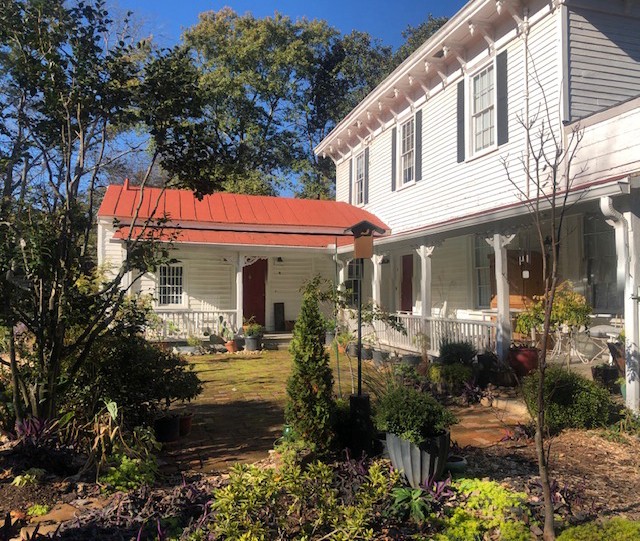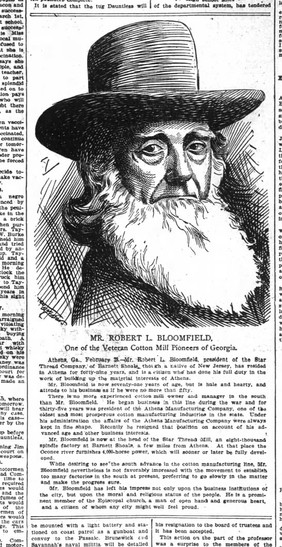House of Robert Bloomfield, President of Athens Manufacturing
Introduction
Text-to-speech Audio
Images



Backstory and Context
Text-to-speech Audio
Robert L. Bloomfield was heavily influential in Athens, but his influence hinged on the economic prowess of the textile manufacturing industry. Textile manufacturing was a big industry in the antebellum American South, but that was not the case when Athens Manufacturing was originally constructed. Before the Embargo Act of 1807, it was not at all a viable industry. Cheap imported textiles were very prevalent, making local production of textiles very inefficient. After the Embargo Act, the War of 1812, and the 1828 “Tariff of Abominations,” American manufacturing grew, even overtaking the cottage manufacturing operations that many southerners initially preferred.
Athens Manufacturing was among these operations. Launched in 1833 by a collection of Athens citizens, its intent was expressly stated to be textile manufacturing. Robert Bloomfield would arrive in Athens in 1849, and within less than twenty years he would be effectively running Athens Manufacturing. Robert Bloomfield was already involved in the business of selling clothing, but as he steadily amassed tracts of land and capital in Athens, his power and wealth increased. As the outbreak of the American Civil War loomed, Bloomfield moved his entire stock of clothing into Atlanta and continued business in the South during wartime. In 1864, he purchased a controlling stock in Athens Manufacturing and became chief agent. He continued to operate as president of the company for thirty three more years. In 1897 (at age 72), he declined to run again for president of Athens Manufacturing, having run the company into debt with an electrification scheme bankrolled by company money. Ashbury H. Hodgson took his position. Ultimately, Athens Manufacturing would continue to operate until the late 1940s.
Although Athens Manufacturing would fall into receivership under his watch, Bloomfield's maintained his reputation as one of Athens' leading citizens. An article in the Atlanta Constitution appropriately called him “a citizen who [had] done his full duty in building up the material interests of Athens.” Not only was he a pioneer in the textile business, but at several points, Bloomfield showed himself to be a dedicated member of the Athens community. He owned a successful pottery, which made sewer pipes among other things, in addition to the textile mill, and he bankrolled the construction of St. Mary's Church so his employees would have a place to worship (R.E.M.'s first performance was in the church in 1980). Bloomfield expanded Athens Manufacturing to the Confederate Armory building (now UGA Surplus) in 1870, helping Athens restart its economy the wake of the Civil War, and Bloomfield's extensive land purchases allowed him to lay the foundations for some of the more successful new neighborhoods in the area. For example, in the 1880s, he was responsible for setting up a popular suburb (named after him) east of Milledge Avenue. Today, Bloomfield Street still stands as a testament to the role of Robert L. Bloomfield in the economic development of post-Civil War Athens.
Sources
"ASBURY H. HODGES IS PRESIDENT: ATHENS MANUFACTURING COMPANY ELECTS A CHIEF EXECUTIVE." The Atlanta
Constitution, April 8, 1897. Accessed via Proquest Ebrary. Web.
Carlisle, Oliva Bloomfield. "Chicopee Mill History" (unpublished manuscript, 1987). Hargrett Rare Book and Manuscript Library, University of Georgia Libraries.
Easom, Maxine Pinson, Patsy Hawkins Arnold, and Gary L. Doster. Across the River: the People, Places, and Culture of East
Athens. Athens, Ga: Across the River, 420 Millstone Circle, 30605, 2019.
Davis, Robert S. “The First Golden Age of Georgia Industry, 1828-1860.” The Georgia Historical Quarterly 72, no. 4 (1988): 699–
710.
Gagnon, Michael J. Transition to an Industrial South: Athens, Georgia, 1830-1870. Baton Rouge: Louisiana State Univ. Press, 2012.
Southern Banner, January 11, 1849. Accessed via Georgia Historic Newspapers. Web.
The Atlanta Constitution, March 1, 1896. Accessed via Newspapers.com. Web.
"The Athens Manufacturing Company Uphholds The Historic Name of the Historic Place of Athens, GA." The Atlanta Constitution,
July 22, 1917. Accessed via Proquest Ebrary. Web.
Thomas, Frances Taliaferro. A Portrait of Historic Athens & Clarke County. Athens: University of Georgia Press, 2009.
Preyer, Norris W. “The Historian, The Slave, and The Ante-Bellum Textile Industry.” The
Journal of Negro History 46, no. 2 (1961): 67–82. https://doi.org/10.2307/2716713.
https://www.newspapers.com/clip/18706281/robert_l_bloomfield/
